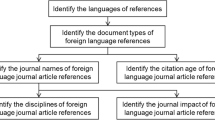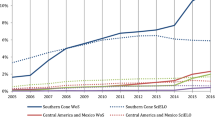Abstract
During the past decades, Chinese science policy has emphasized the international dissemination of research. Such policies were associated with exponential growth of English-language publications and have led China to become the largest contributor to international scientific literature. However, due to the paywalls and language barriers, China’s international publications are less accessible to local Chinese scholars, which suggests that the dissemination to the international scientific community may come at the expense of dissemination to the local Chinese community. This paper investigates the local accessibility of China’s international publications and finds that publishing internationally limits the visibility of Chinese research for the national Chinese scientific community, and the restriction is even worse for immediate access.



Similar content being viewed by others
Notes
In this study, international journals/publications refer to all journals/publications indexed by major international bibliometric databases (e.g., Web of Science, Scopus, etc.) while national journals/publications refer to all journals/publications indexed by national Chinese bibliometric databases, regardless of language.
Although some social science and humanity (SSH) papers from multidisciplinary journals are also indexed by CSCD, the representation of SSH is very low in CSCD.
The conversion table will be shared as an appendix with permission from Clarivate (Clarivate Analytics. (n.d.)).
The period between 2011 and 2015 is China’s 12th 5-year plan, which is a series of social and economic development (including science and technology development) initiatives issued by the Chinese Communist Party (CCP). Most policies are consistent during the 5-year plan while the changes will happen in the next 5-year plan.
References
Baidu. (2021). Project Chengfeng 2021 [Press release]. Retrieved from http://cn.chinadaily.com.cn/a/202101/08/WS5ff7f34ba3101e7ce9739cec.html
Baldi, S. (1998). Normative versus social constructivist processes in the allocation of citations: A network-analytic model. American Sociological Review, 63(6), 829–846.
Bekavac, A., Petrak, J., & Buneta, Z. (1994). Citation behavior and place of publication in the authors from the scientific periphery: A matter of quality? Information Processing & Management, 30(1), 33–42. https://doi.org/10.1016/0306-4573(94)90022-1
Chavarro, D., Tang, P., & Ràfols, I. (2017). Why researchers publish in non-mainstream journals: Training, knowledge bridging, and gap filling. Research Policy, 46(9), 1666–1680. https://doi.org/10.1016/j.respol.2017.08.002
Clarivate Analytics. (n.d.) Research Areas (Categories/Classification). Retrieved from https://images.webofknowledge.com/images/help/WOS/hp_research_areas_easca.html
de Price, D. J. S. (1963). Little science, big science. Columbia Univ. Press.
Franzoni, C., Scellato, G., & Stephan, P. (2011). Changing incentives to publish. Science, 333(6043), 702–703.
Guo, Y. (2011). Online library and copyright protection. Journal of Digital Research Publishing, 2011, 73–80.
Haustein, S. (2012). Multidimensional journal evaluation: Analyzing scientific periodicals beyond the impact factor. Berlin: De Gruyter/Saur.
ISTIC. (2020). Statistical Data of Chinese S&T Papers 2020. Retrieved from Beijing:
Jin, B., & Wang, B. (1999). Chinese science citation database: Its construction and application. Scientometrics, 45(2), 325–332.
Jin, B., Zhang, J., Chen, D., & Zhu, X. (2002). Development of the Chinese Scientometric Indicators (CSI). Scientometrics, 54(1), 145–154.
Lariviere, V., Gong, K., & Sugimoto, C. R. (2018). Citations strength begins at home. Nature, 564(7735), S70–S70.
Larivière, V., Haustein, S., & Mongeon, P. (2015). The oligopoly of academic publishers in the digital era. PLoS ONE, 10(6), e0127502.
Larivière, V., Shu, F., & Sugimoto, C. R. (2020). The Coronavirus (COVID-19) outbreak highlights serious deficiencies in scholarly communication. LSE Impact Blog. Retrieved from https://blogs.lse.ac.uk/impactofsocialsciences/2020/03/05/the-coronavirus-covid-19-outbreak-highlights-serious-deficiencies-in-scholarly-communication/
Lee, C. J., Sugimoto, C. R., Zhang, G., & Cronin, B. (2013). Bias in peer review. ASI Journal of the American Society for Information Science and Technology, 64(1), 2–17.
Liu, C.-E. (2018). Ba Lun Wen Xie Zai Zu Guo Da Di Shang —— Guo Nei Ke Yan Lun Wen Wai Liu Xian Xiang Fen Xi (Publishing papers at hone—Analysis of the outflow of the domestic scientific research papers). Journal of Beijing University of Technology (social Science Edition), 18(2), 64–72.
Ma, Z. (2019). The Relevance of National Journals from a Chinese Perspective. In W. Glänzel, H. F. Moed, U. Schmoch, & M. Thelwall (Eds.), Springer Handbook of Science and Technology Indicators (pp. 505–562). Springer International Publishing.
Merton, R. K. (1957). Priorities in scientific discovery: A chapter in the sociology of science. American Sociological Review, 22(6), 635–659.
Merton, R. K. (1988). The matthew effect in science, II: Cumulative advantage and the symbolism of intellectual property. Isis, 79(4), 606–623.
Ministry of Science and Technology of China. (2020). Guan yu po chu ke ji ping jia zhong “wei lun wen ”bu liang dao xiang de ruo gan cuo shi (On eliminating the abusive use of number of publications in research evaluation). Beijing: Government of People's Republic of China Retrieved from http://www.most.gov.cn/mostinfo/xinxifenlei/fgzc/gfxwj/gfxwj2020/202002/t20200223_151781.htm.
Ministry of Education of China, & Ministry of Science and Technology of China. (2020). Guan yu gui fan gao deng xue xiao SCI lun wen xiang guan zhi biao shi yong shu li zheng que ping jia dao xiang de ruo gan yi jian (On regulating the use of the number of SCI papers as well as bibliometric indicators on university research evaluation). Beijing: Government of People's Republic of China Retrieved from http://www.moe.gov.cn/srcsite/A16/moe_784/202002/t20200223_423334.html.
Moed, H. (2002). Measuring China’s research performance using the science citation index. Scientometrics, 53(3), 281–296.
Mongeon, P., Siler, K., Archambault, A., Sugimoto, C. R., & Larivière, V. (2021). Collection development in the era of big deals. College and Research Libraries, 82(2), 219–236. https://doi.org/10.5860/crl.82.2.219
Montgomery, S. L. (2013). Does science need a global language? English and the future of research. The University of Chicago Press.
National Science Board. (2018). Science and Engineering Indicators 2018. (NSB-2018–1). Alexandria, VA: National Science Foundation Retrieved from https://www.nsf.gov/statistics/indicators/.
People's Republic of China. (2007). Law of the People’s Republic of China on Science and Technology Progress, Beijing, China
Quan, W., Chen, B., & Shu, F. (2017). Publish or impoverish: An investigation of the monetary reward system of science in China (1999–2016). Aslib Journal of Information Management, 69(5), 486–502.
Rodríguez-Bravo, B., Fernández-Ramos, A., & Travieso-Rodríguez, C. (2021). Relationship between downloads and cites of academic journals in the field of library and information science: The case of public universities in Castilla y León. Revista Espanola De Documentacion Cientifica, 44(4), 1–20. https://doi.org/10.3989/redc.2021.3.1806
Schiermeier, Q. (2018). China backs bold plan to tear down journal paywalls. Nature, 564(7735), 171–173.
Shu, F., Julien, C.-A., & Larivière, V. (2019a). Does the web of science accurately represent Chinese scientific performance? Journal of the Association for Information Science and Technology, 70(10), 1138–1152. https://doi.org/10.1002/asi.24184
Shu, F., Julien, C.-A., Zhang, L., Qiu, J., Zhang, J., & Larivière, V. (2019b). Comparing journal and paper level classifications of science. Journal of Informetrics, 13(1), 202–225.
Shu, F., Liu, S., & Larivière, V. (2022). China’s research evaluation reform: What are the consequences for global science? Minerva. https://doi.org/10.1007/s11024-022-09468-7
Shu, F., Lou, W., & Haustein, S. (2018a). Can twitter increase the visibility of Chinese publications? Scientometrics, 116(1), 505–519. https://doi.org/10.1007/s11192-018-2732-8
Shu, F., Mongeon, P., Haustein, S., Siler, K., Alperin, J. P., & Larivière, V. (2018b). Is it such a big deal? On the cost of journal use in the digital era. College & Research Libraries, 79(6), 785–798.
Shu, F., Quan, W., Chen, B., Qiu, J., Sugimoto, C. R., & Larivière, V. (2020). The role of web of science publications in China’s tenure system. Scientometrics, 122(3), 1683–1695. https://doi.org/10.1007/s11192-019-03339-x
Smith, A. C., Merz, L., Borden, J. B., Gulick, C. K., Kshirsagar, A. R., & Bruna, E. M. (2022). Assessing the effect of article processing charges on the geographic diversity of authors using Elsevier’s “Mirror Journal” system. Quantitative Science Studies, 2(4), 1123–1143. https://doi.org/10.1162/qss_a_00157
Wu, H.-H., & Wang, B. (2021). 2020 Nian Zhong Guo Gao Xiao Tu Shu Guan Ji Ben Tong Ji Shu Ju Bao Gao (Statistical Report of University Library 2020). Journal of Academic Libraries, 39(04), 5–11. https://doi.org/10.16603/j.issn1002-1027.2021.04.001
Xi, J. (2016). Struggle for building a world science and technology power: Speech at the National Science and Technology Innovation Conference, the Academician Conference of the Two Academy of Sciences, and the Ninth National Congress of the Chinese Science and Technology Association. Beijing: Xinhua News Agency Retrieved from http://www.xinhuanet.com//politics/2016-05/31/c_1118965169.htm.
Zhang, L., & Sivertsen, G. (2020). The new research assessment reform in China and its implementation. Scholarly Assessment Reports, 2(1), 3. https://doi.org/10.29024/sar.15
Zou, T., & Zhang, X. (2017). Lun Wo Guo Ke Yan Ping Jia Ti Zhi Zhong De “ Er Lü Bei Fan ”—— Dui Tu You You Huo Nuo Bei Er Jiang Yin Fa Zheng Yi De Zai Si Kao (A discussion on the antinomy of China’s scientific research evaluation system: taking Tu Youyou’s Nobel Prize winning as an example). Journal of Higher Education Management, 11(4), 76–82.
Acknowledgements
This work is supported by Zhejiang Provincial Philosophy and Social Sciences Planning Project (22NDJC085YB).
Author information
Authors and Affiliations
Corresponding author
Ethics declarations
Conflict of interest
The authors declare they have no financial interests except for the funding supported by Zhejiang Provincial Philosopy and Social Sciences Planning Project that has been claimed in the acknowledgement.
Rights and permissions
Springer Nature or its licensor holds exclusive rights to this article under a publishing agreement with the author(s) or other rightsholder(s); author self-archiving of the accepted manuscript version of this article is solely governed by the terms of such publishing agreement and applicable law.
About this article
Cite this article
Shu, F., Wang, X., Liu, S. et al. Global impact or national accessibility? A paradox in China’s science. Scientometrics 128, 263–277 (2023). https://doi.org/10.1007/s11192-022-04537-w
Received:
Accepted:
Published:
Issue Date:
DOI: https://doi.org/10.1007/s11192-022-04537-w




